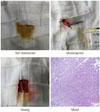2. Tanaka K, Tomita H, Osada S, Watanabe H, Imai H, Sasaki Y, et al. Significance of histopathological evaluation of pancreatic fibrosis to predict postoperative course after pancreatic surgery. Anticancer Res. 2015; 35:1749–1756.

3. Lu X, Chen Y. Pathologic assessment of pancreatic fibrosis in predicting pancreatic fistula and management of prophylactic drain removal after pancreaticoduodenectomy. World J Surg. 2016; 40:1520–1521.


4. Nagathihalli NS, Castellanos JA, VanSaun MN, Dai X, Ambrose M, Guo Q, et al. Pancreatic stellate cell secreted IL-6 stimulates STAT3 dependent invasiveness of pancreatic intraepithelial neoplasia and cancer cells. Oncotarget. 2016; 7:65982–65992.

7. Xu L, Zheng N, He Q, Li R, Zhang K, Liang T. Puerarin, isolated from Pueraria lobata (Willd.), protects against hepatotoxicity via specific inhibition of the TGF-β1/Smad signaling pathway, thereby leading to anti-fibrotic effect. Phytomedicine. 2013; 20:1172–1179.


8. Zhang YJ, Chan J, Xiang MX, Cheng G, Wang SS. Effect of matrine on fibrosis of hypertrophy myocardium induced by pressure overload. Bull Sci Technol. 2007; 23:67–71.
10. Zhang HW, Jin Y. [Renoprotective effects of matrine on experimental glomerulosclerosis in rats]. Zhonghua Er Ke Za Zhi. 2004; 42:737–740.

11. Yuan X, Sun H, Miao R, Zhang Z, Zhao X, Guo Y, et al. Effect of matrine on NF-κB and collagen protein III of rats with pulmonary fibrosis. J Xinxiang Med College. 2009; 26:327–330.
12. Bikádi P, Szabó J, Szabára Á, Jakab C. Internal positive controls of alpha-smooth muscle actin (α-SMA) in bovine tissues Immunohistochemical study. Magyar Allatorvosok Lapja. 2015; 137:151–158.
13. Meng LP, Wang GG, Hu MX, Zhang H, Guan B, Hong YP. The correlation of magnetic resonance perfusion parameters and CD34, a-SMA of liver fibrosis and cirrhosis in rats. Radiol Pract. 2016; 31:580–585.
14. Hu GX, Wan ZY, Shao JL, Zhang Y, Zhang LL, Gong ZJ. [Effects of hydroxycamptothecin on TGFb1, a-SMA and collagen I expression in rat hepatic satellite cells]. Zhonghua Gan Zang Bing Za Zhi. 2012; 20:453–457.
15. De Jesus Araújo L, Yamamoto De Almeida L, Santos Lima J, Martelli-Júnior H, Ferreti Bonan PR. Evaluation of MMP-1, MMP-10, TIMP-1, a-SMA and TGF-b1 in angiofibromas of tuberous sclerosis. Minerva Stomatol. 2011; 60:25–33.

18. Yan X, Liao H, Cheng M, Shi X, Lin X, Feng XH, et al. Smad7 protein interacts with receptor-regulated Smads (R-Smads) to inhibit transforming growth factor-β (TGF-β)/Smad signaling. J Biol Chem. 2016; 291:382–392.


19. Da C, Liu Y, Zhan Y, Liu K, Wang R. Nobiletin inhibits epithelialmesenchymal transition of human non-small cell lung cancer cells by antagonizing the TGF-β1/Smad3 signaling pathway. Oncol Rep. 2016; 35:2767–2774.


21. Zhang YB, Zhan LQ, Li GQ, Wang F, Wang Y, Li YL, et al. Dimeric matrine-type alkaloids from the roots of Sophora flavescens and their anti-epatitis B virus activities. J Org Chem. 2016; 81:6273–6280.


22. Zhou Y, Wu Y, Deng L, Chen L, Zhao D, Lv L, et al. The alkaloid matrine of the root of Sophora flavescens prevents arrhythmogenic effect of ouabain. Phytomedicine. 2014; 21:931–935.


24. Pu J, Fang FF, Li XQ, Shu ZH, Jiang YP, Han T, et al. Matrine exerts a strong anti-arthritic effect on type II collagen-induced arthritis in rats by inhibiting inflammatory responses. Int J Mol Sci. 2016; 17:1410.


25. Liu Z, Yang Y, Xu J, Jiang X, Wang J. GW27-e1128 Matrine inhibits cardiac fibrosis by inhibiting TGFβ1/smad signaling pathway. J Am Coll Cardiol. 2016; 68:16 Suppl. C40.
26. Mihailova S, Ivanova-Genova E, Lukanov T, Stoyanova V, Milanova V, Naumova E. A study of TNF-α, TGF-β, IL-10, IL-6, and IFN-γ gene polymorphisms in patients with depression. J Neuroimmunol. 2016; 293:123–128.


27. Yang P, Wu Z, Huang J, Wang A, Xu S, You P, et al. Regulation of fibroblasts proliferation and function of human hypertrophic scar by Oxymatrine through TGF-β signaling pathway. Chin J Aesth Plast Surg. 2010; 21:557–559.
28. Zhang Y, Cui L, Guan G, Wang J, Qiu C, Yang T, et al. Matrine suppresses cardiac fibrosis by inhibiting the TGF-β/Smad pathway in experimental diabetic cardiomyopathy. Mol Med Rep. 2018; 17:1775–1781.


29. Zhao N, Pan S, Zhang Y, Liu X, Guan G, Wang J, et al. TGF-β/ Smads signal pathway is involved in the anti-fibrotic effect of matrine and improvement of the cardiac function in the diabetic cardiomyopathy rats. J Shanxi Med Univ. 2015; 13:312–327.










 PDF
PDF ePub
ePub Citation
Citation Print
Print



 XML Download
XML Download